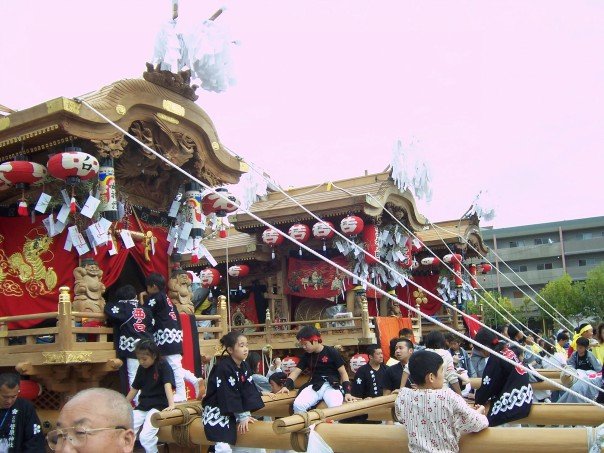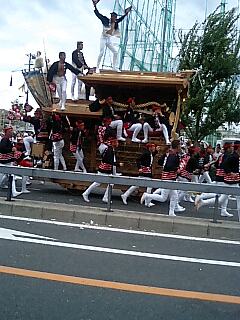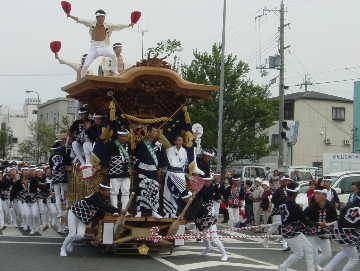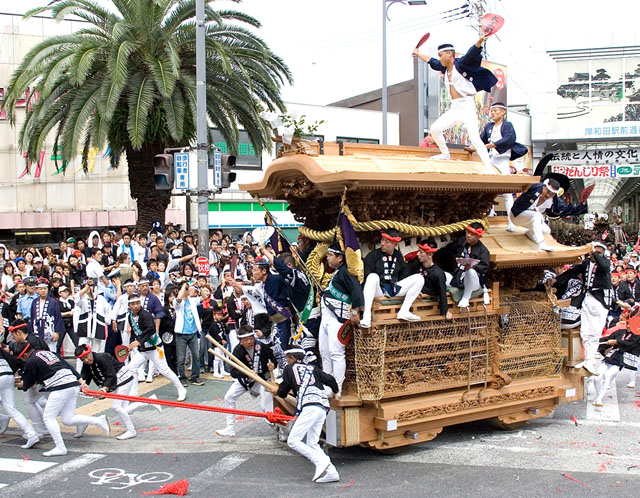
Typical Danjiri floats (this and others courtesy Wikicommons)
The Kansai Scene this month has a special feature on Kansai’s Danjri festivals. These autumn festivals are a high-speed dangerous version of the more sedate Gion Matsuri, with elaborate carts sponsored by particular areas racing through the streets, resulting sometimes in damaged buildings and occasionally in death. The most famous of them is the Kishiwada Danjiri Matsuri, which takes place in September. There’s a well-produced five minute video of it here, which gives a sense of the risks involved.
*****************************************************
Dashing Danjiri Draw Kansai Crowds
by Sam Evans • Oct 1, 2014
Danjiri festivals are some of Japan’s most enchanting spectacles, and the most revered of them all is held just a stone’s throw away from us Kansai dwellers in the south Osaka town of Kishiwada.

Much of the excitement comes from the figure stood perilously on top of the float
The famous Kishiwada Danjiri Matsuri dates back to 1703 when the town’s daimyo (feudal lord), Okabe Nagayasu, created a festival to pray to shinto gods for a bountiful harvest. The festival’s popularity grew rapidly as, for this short period, the otherwise strictly-prohibited locals were permitted into the castle’s grounds to drag danjiri (portable shrines) through the area.
The competitive nature that spawned from attempts to outdo each other before the eyes of the daimyo has since evolved into the modern-day festival, in which armies of young men from surrounding neighborhoods heave their danjiri through the town in an exhibition of strength, agility and bravery. But what is it that makes Danjiri Matsuri unique among the thousands of festivals in the Japanese calendar?
Arriving in Kishiwada at the stroke of 10am, the streets are already jam-packed with people, but luckily I manage to squeeze into a prime spot outside the station where the festival is filmed for national TV. Excitement and anticipation fills the air as well as the aroma from the myriad of street vendors selling everything from Indian cuisine to Brazilian barbecue to the staple Kansai treats okonomiyaki and takoyaki. The danjiri have been touring other parts of town since 6am when the hiki-dashi, or “opening pull”, signalled the beginning of the festival. Now, the hayashi (the drum and flute music played on the floats) echoes from out of sight, growing ever louder to signal their imminent arrival to the main street.
The crowd erupts as the first of many danjiri comes into view, lugged by dozens of men dressed immaculately in their troop’s traditional uniform. The floats themselves are four-ton colossal works of art made exclusively of keiyaki (zelkova) wood and interestingly, without the use of a single nail. Each group’s danjiri is adorned with carvings called horimono which depict scenes from historical battles and add further to their majestic beauty. But just as I find myself getting lost in the intricate patterns, I’m snapped out of it by the intensified beating of taiko (drums).

With performers on top of the roof, the floats race at high speed through crowded streets
The action is about the begin. The troop stops and the ropes used to haul the floats become taut and the ubiquitous chanting loudens. Suddenly, in an explosion of flutes and cheers the danjiri is pulled to running speed and made to skid around the corner; the man on the float’s roof jumps and dances athletically while desperately trying not to lose balance and fall to his death like some have in years past.
This exhilarating performance is repeated as different troops parade along the main street, looking increasingly exhausted as the sweltering day draws on. At this point I took the opportunity to talk with Masaharu Ishikawa, a veteran of the Nimura troop in Takaishi City’s festival. He talks about what danjiri events mean to their participants: “I have pride in my danjiri group because we represent my hometown, Higashi Hagoromo. My uncle, cousin and best friends are all in the same group and it’s this sense of camaraderie that makes danjiri very important to us. I’m sure other groups feel the same way, but I think my group is the best and the most fun.”
Masaharu reveals that troops begin training twice a week in the months before the festival, increasing their regime to a gruelling 1-3 hours of running and pulling practice every day in the final few weeks. “Turning corners is especially exhausting and it takes a lot of practice, but it’s worth it because the festival is so exciting! Afterwards, all the girls want to take pictures with us and at night my group and I barbecue together.”
As day turns to night the festival does indeed grow more benign. The pace slows as the danjiri are embellished with lanterns and coaxed through the streets in a procession resembling a Disneyland parade. The mobile shrines are then parked together for everyone to admire closely, the hiyashi music still whistling tenderly in the background as the stars of the show take a well-deserved rest. The dazzling Kishiwada Danjiri Matsuri is over for another year, though Kansai is awash with danjiri festivals throughout October that, although not quite as famous as this one, make up for in convenience what they lack in size. Forget about arriving early for a spot or having to fight through a sea of people to get to a food stall. These later festivals are ideal for a more laid-back weekend jaunt where one can still experience danjiri at its truest, just in a more intimate atmosphere.

Excitement as a float turns a corner at the Kishiwada Danjiri Matsuri (courtesy Edge Wave Sensor)
Kishiwada City
Oct 11 (6-10pm), Oct 12 (7- 10pm) Kishiwada’s more spiritual danjiri festival. 47 floats as opposed to the September festival’s 34. Access: Around Kumeda, Shimomatsu and Higashi Kishiwada Stns on the JR Hanwa line
Takaishi City
Oct 11 (2-5pm), Oct 12 (9-11am, 1-5pm) A more grassroots danjiri festival with less TV cameras and more of a homely vibe. Access: Nankai Line, Takaishi Stn, East Exit
Sakai City
Oct 3, 5,11 & 12 (afternoon/evening) Similarly underpublicised compared to Kishiwada’s matsuri, experience the pride and passion of the people of Sakai. Access: With so many shrines along these routes, the best bet is to get to JR Sakai Stn and follow the crowds to the nearby viewing spots.
Nada no Kenka “fighting” Danjiri festival, Himeji City
Oct 11 & 12 (all day) If Kishiwada’s festival is dangerous then this is outright carnage. Watch as the different troops ferociously clash their danjiri together. Fight on! Access: Matsubara Hachiman Shrine; 3-min walk from Shirahamanomiya Stn on the Sanyo Dentetsu honsen line

Leave a Reply